Abstract
Twenty strains of capsular type II Staphylococcus epidermidis, determined by the method of Ichiman, were obtained from clinical specimens. Among them, 5, 5, and 10 strains were 4+, 3+, and 2+ in the intensities of their reactions against fluorescent antibody, respectively. Strains exhibiting 4+ and 3+ intensities were mouse virulent and phage nontypable, while 2+ strains were mouse avirulent and phage typable. When three strains randomly selected from each of the mouse-virulent and mouse-avirulent strains were compared in terms of their cell volume indices, all mouse-virulent strains had significantly higher indices (average, 1.86 times) than the mouse-avirulent strains. With intraperitoneal injection of the strains into mice, strains with higher cell volume indices resisted ingestion by peritoneal cells, while strains with low cell volume indices were sensitive to phagocytosis. When the capacity to absorb a definite amount of passive protective activity in rabbit antiserum prepared with capsular type II strains was compared among these strains, 10 to 20 mg of mouse-virulent strains was capable of completely absorbing the passive protective activity, whereas more than 80 mg of the cells was required for similar absorption by mouse-avirulent strains. In ultra-thin sections of three mouse-virulent strains stained with ferritin-conjugated rabbit antiserum, well-defined capsules were detected around cell walls; however, no capsule was seen around the walls of three mouse-avirulent strains.
Full text
PDF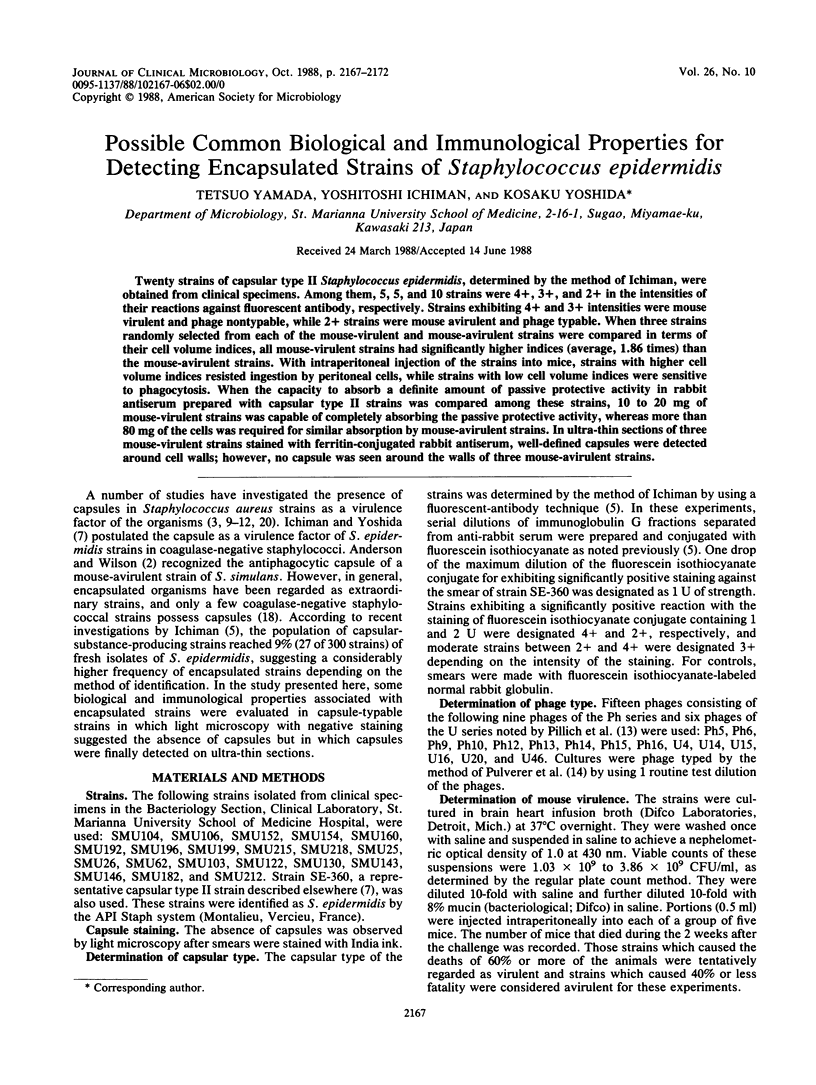
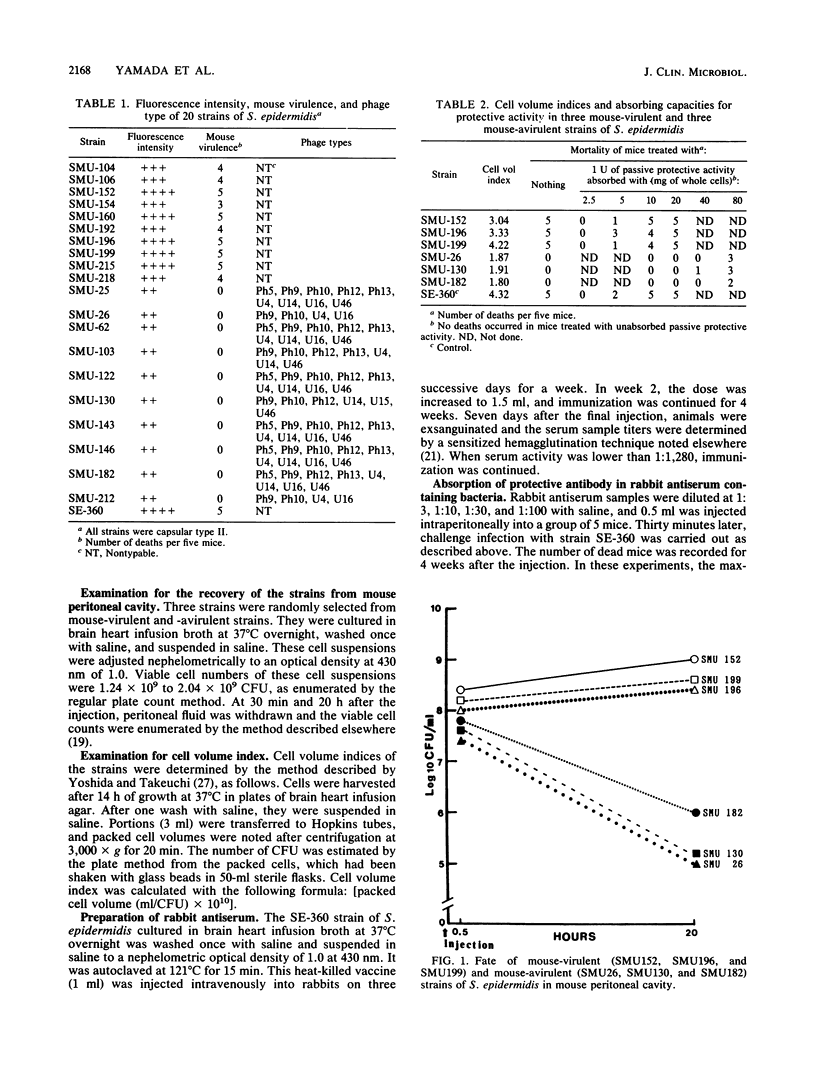
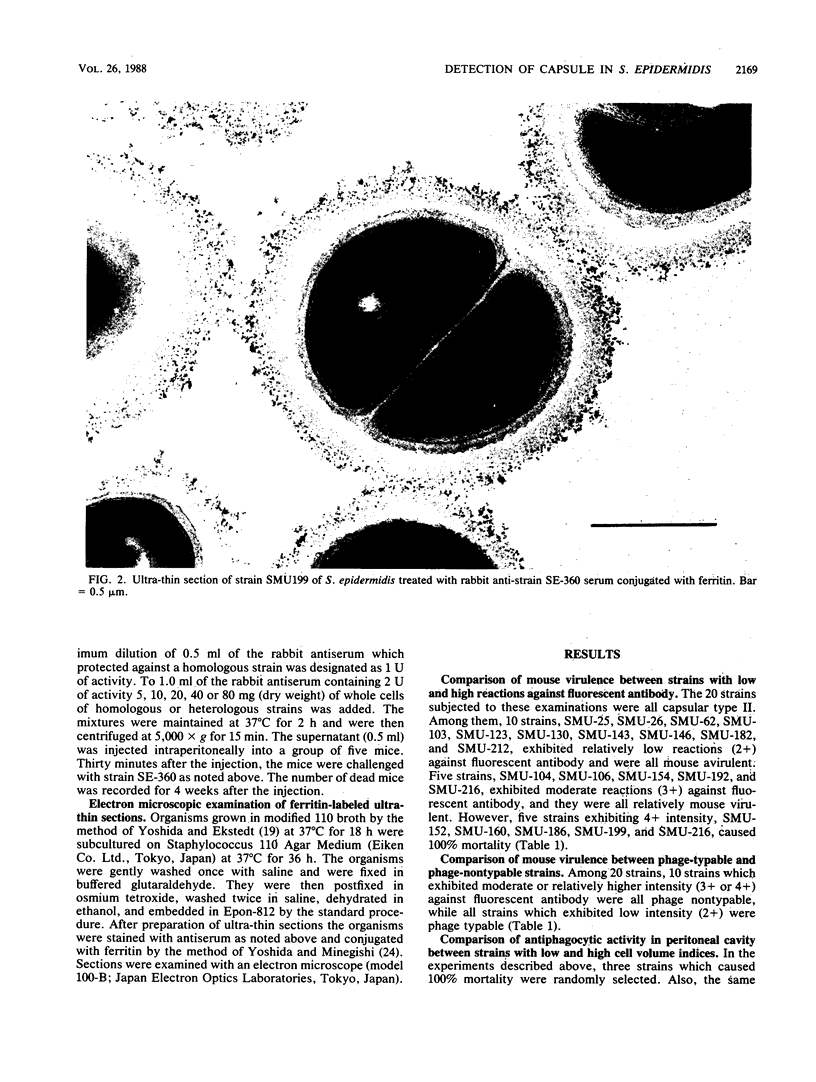
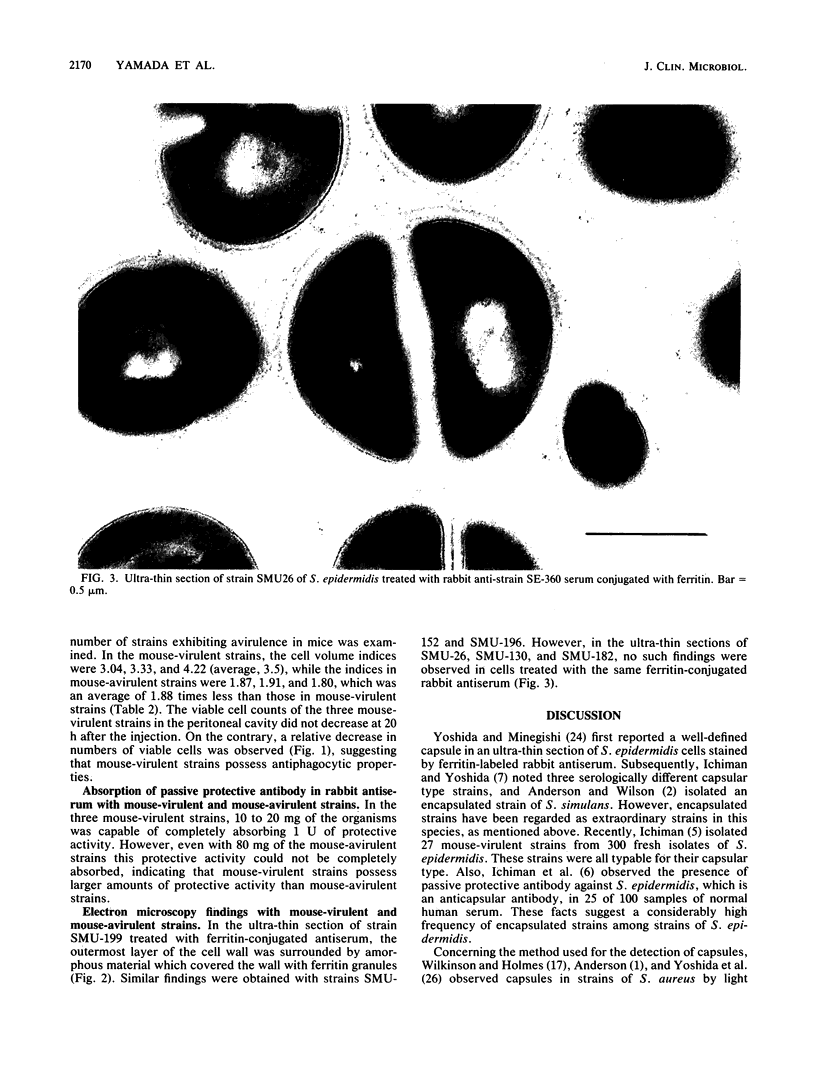

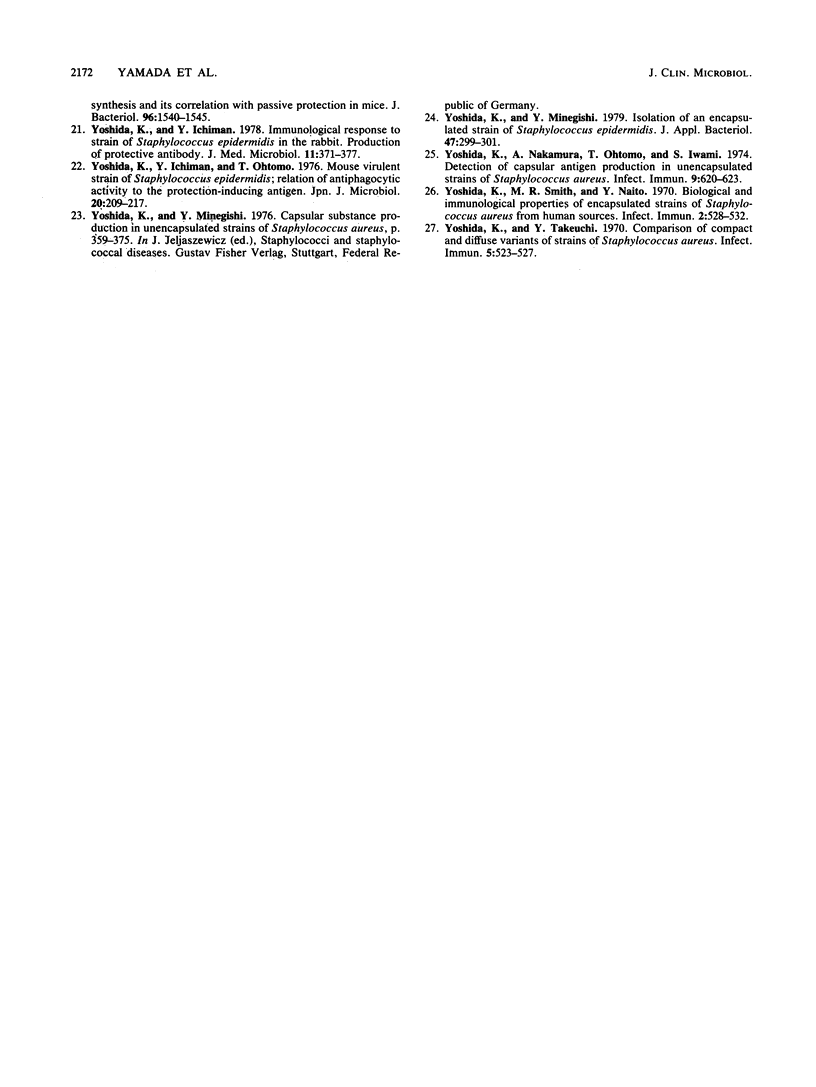
Images in this article
Selected References
These references are in PubMed. This may not be the complete list of references from this article.
- Anderson J. C. Absence of encapsulation in strains of Staphylococcus aureus isolated from bovine mastitis. Res Vet Sci. 1984 Nov;37(3):359–361. [PubMed] [Google Scholar]
- Anderson J. C., Wilson C. D. Encapsulated, coagulase-negative strain of Staphylococcus simulans. Infect Immun. 1981 Jul;33(1):304–308. doi: 10.1128/iai.33.1.304-308.1981. [DOI] [PMC free article] [PubMed] [Google Scholar]
- Ekstedt R. D. Mechanisms of resistance to staphylococcal infection: natural and acquired. Ann N Y Acad Sci. 1965 Jul 23;128(1):301–334. doi: 10.1111/j.1749-6632.1965.tb11646.x. [DOI] [PubMed] [Google Scholar]
- FISHER M. W., DEVLIN H. B., ERLANDSON A. L. A NEW STAPHYLOCOCCAL ANTIGEN. ITS PREPARATION AND IMMUNIZING ACTIVITY AGAINST EXPERIMENTAL INFECTIONS. Nature. 1963 Sep 14;199:1074–1075. doi: 10.1038/1991074a0. [DOI] [PubMed] [Google Scholar]
- Ichiman Y. Applications of fluorescent antibody for detecting capsular substances in Staphylococcus epidermidis. J Appl Bacteriol. 1984 Apr;56(2):311–316. doi: 10.1111/j.1365-2672.1984.tb01352.x. [DOI] [PubMed] [Google Scholar]
- Ichiman Y., Yamada T., Yoshida K. Protective antibodies in human sera against encapsulated strains of Staphylococcus epidermidis. J Appl Bacteriol. 1987 Aug;63(2):165–169. doi: 10.1111/j.1365-2672.1987.tb02699.x. [DOI] [PubMed] [Google Scholar]
- Ichiman Y., Yoshida K. The relationship of capsular-type of Staphylococcus epidermidis to virulence and induction of resistance in the mouse. J Appl Bacteriol. 1981 Oct;51(2):229–241. doi: 10.1111/j.1365-2672.1981.tb01237.x. [DOI] [PubMed] [Google Scholar]
- KOENIG M. G. Factors relating to the virulence of staphylococci. I. Comparative studies on two colonial variants. Yale J Biol Med. 1962 Jun;34:537–559. [PMC free article] [PubMed] [Google Scholar]
- KOENIG M. G., MELLY M. A., ROGERS D. E. Factors relating to the virulence of Staphylococci. II. Observations on four mouse-pathogenic strains. J Exp Med. 1962 Nov 1;116:589–599. doi: 10.1084/jem.116.5.589. [DOI] [PMC free article] [PubMed] [Google Scholar]
- Lee J. C., Betley M. J., Hopkins C. A., Perez N. E., Pier G. B. Virulence studies, in mice, of transposon-induced mutants of Staphylococcus aureus differing in capsule size. J Infect Dis. 1987 Nov;156(5):741–750. doi: 10.1093/infdis/156.5.741. [DOI] [PubMed] [Google Scholar]
- Melly M. A., Duke L. J., Liau D. F., Hash J. H. Biological properties of the encapsulated Staphylococcus aureus M. Infect Immun. 1974 Aug;10(2):389–397. doi: 10.1128/iai.10.2.389-397.1974. [DOI] [PMC free article] [PubMed] [Google Scholar]
- Parker S. E., Warner P., Slipetz W. K. Estimation of virulence of Staphylococcus aureus for mice: the exceptional virulence of the Smith strain. Can J Microbiol. 1966 Aug;12(4):753–762. doi: 10.1139/m66-102. [DOI] [PubMed] [Google Scholar]
- Pillich J., Pulverer G., Klein A., Vojtisková M. A proposal for further modification of the phage-typing system for coagulase-negative staphylococci. Zentralbl Bakteriol Orig A. 1978 Jul;241(1):83–94. [PubMed] [Google Scholar]
- Pulverer G., Pillich J., Klein A. New bacteriophages of Staphylococcus epidermidis. J Infect Dis. 1975 Nov;132(5):524–531. doi: 10.1093/infdis/132.5.524. [DOI] [PubMed] [Google Scholar]
- Sompolinsky D., Samra Z., Karakawa W. W., Vann W. F., Schneerson R., Malik Z. Encapsulation and capsular types in isolates of Staphylococcus aureus from different sources and relationship to phage types. J Clin Microbiol. 1985 Nov;22(5):828–834. doi: 10.1128/jcm.22.5.828-834.1985. [DOI] [PMC free article] [PubMed] [Google Scholar]
- Wiley B. B. Capsule size, coagulase production, and egg virulence among certain strains of Staphylococcus aureus. Can J Microbiol. 1968 Jun;14(6):685–689. doi: 10.1139/m68-114. [DOI] [PubMed] [Google Scholar]
- Wilkinson B. J., Holmes K. M. Staphylococcus aureus cell surface: capsule as a barrier to bacteriophage adsorption. Infect Immun. 1979 Feb;23(2):549–552. doi: 10.1128/iai.23.2.549-552.1979. [DOI] [PMC free article] [PubMed] [Google Scholar]
- Yoshida K., Ekstedt R. D. Relation of mucoid growth of Staphylococcus aureus to clumping factor reaction, morphology in serum-soft agar, and virulence. J Bacteriol. 1968 Oct;96(4):902–908. doi: 10.1128/jb.96.4.902-908.1968. [DOI] [PMC free article] [PubMed] [Google Scholar]
- Yoshida K., Ichiman Y. Immunological response to a strain of Staphylococcus epidermidis in the rabbit: production of protective antibody. J Med Microbiol. 1978 Nov;11(4):371–377. doi: 10.1099/00222615-11-4-371. [DOI] [PubMed] [Google Scholar]
- Yoshida K., Ichiman Y., Ohtomo T. Mouse virulent strain of Staphylococcus epidermidis. Relation of antiphagocytic activity to the protection-inducing antigen. Jpn J Microbiol. 1976 Jun;20(3):209–217. [PubMed] [Google Scholar]
- Yoshida K., Minegishi Y. Isolation of an encapsulated strain of Staphylococcus epidermidis. J Appl Bacteriol. 1979 Oct;47(2):299–301. doi: 10.1111/j.1365-2672.1979.tb01758.x. [DOI] [PubMed] [Google Scholar]
- Yoshida K., Nakamura A., Otomo T., Iwami S. Detection of capsular antigen production in unencapsulated strains of Staphylococcus aureus. Infect Immun. 1974 Apr;9(4):620–623. doi: 10.1128/iai.9.4.620-623.1974. [DOI] [PMC free article] [PubMed] [Google Scholar]
- Yoshida K., Smith M. R., Naito Y. Biological and Immunological Properties of Encapsulated Strains of Staphylococcus aureus from Human Sources. Infect Immun. 1970 Nov;2(5):528–532. doi: 10.1128/iai.2.5.528-532.1970. [DOI] [PMC free article] [PubMed] [Google Scholar]
- Yoshida K., Takeuchi Y. Comparison of Compact and Diffuse Variants of Strains of Staphylococcus aureus. Infect Immun. 1970 Nov;2(5):523–527. doi: 10.1128/iai.2.5.523-527.1970. [DOI] [PMC free article] [PubMed] [Google Scholar]




